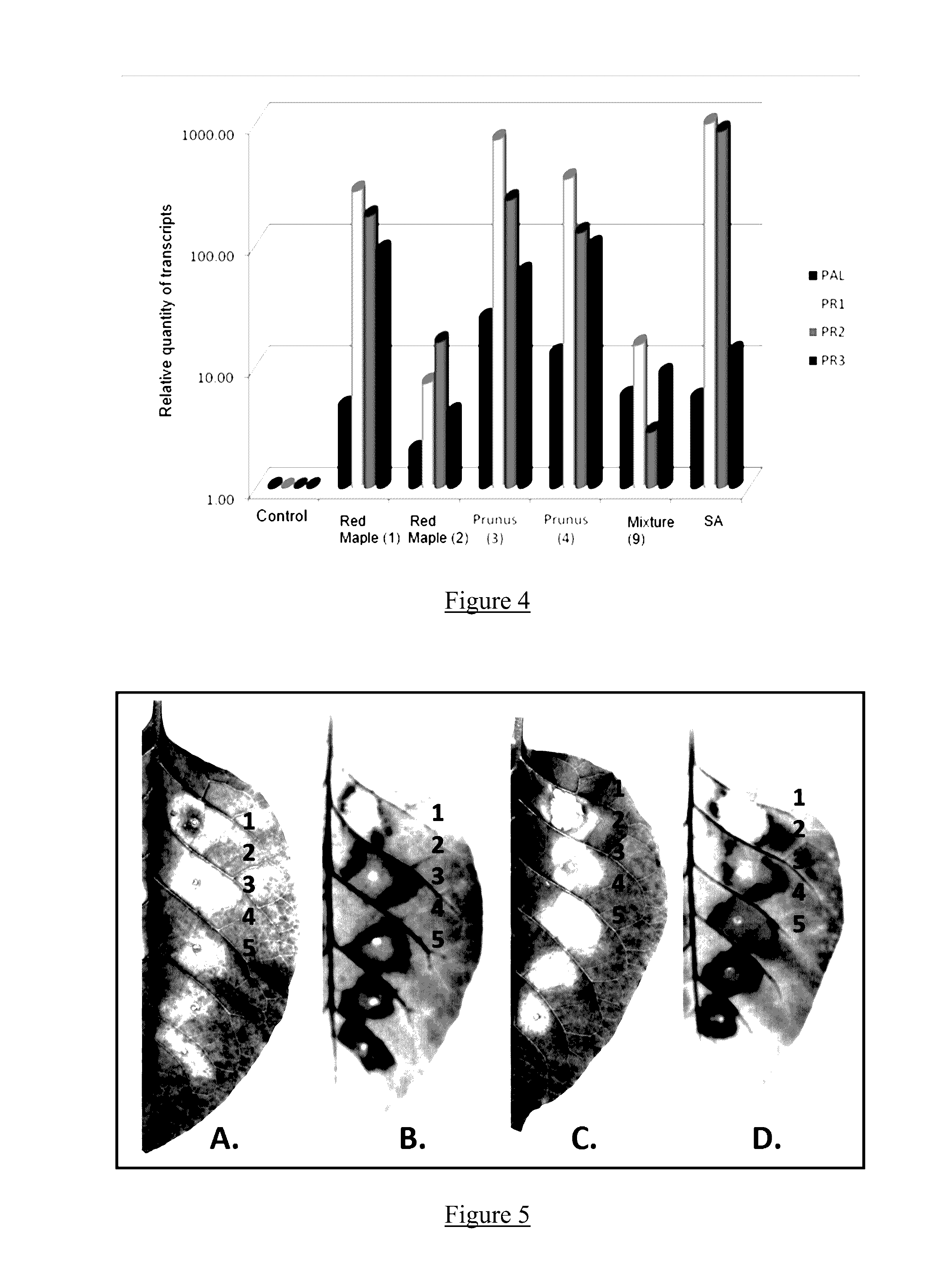Method for reusing leaves from arborescent woody plants, for the phytopharmaceutical industry
a technology reusing leaves, applied in the field of reusing deciduous leaves of arborescent woody plants, for the phytopharmaceutical industry, can solve problems such as left to ro
- Summary
- Abstract
- Description
- Claims
- Application Information
AI Technical Summary
Benefits of technology
Problems solved by technology
Method used
Image
Examples
example 1
Synthesis and Characterization of Extracts From Deciduous Leaves of Arborescent Woody Plants
[0075]Harvest
[0076]Four arborescent woody plants were used as sources of deciduous leaves to obtain nine different extracts. The deciduous leaves were collected in August or in November, before or after abscission. Those collected in August do not show symptoms of leaf senescence, while those collected in November show these symptoms with autumn colors. Table 1 lists the leaf sources used.
TABLE 1Sources of deciduous leaves usedExtract no.123456789ArborescentRed maplePrunusPlatanusRed oakMixture ofwoody plantsenescentleavesCollectionAugustNov.AugustNov.Nov.Nov.Nov.Nov.Nov.periodbeforebeforebeforebeforebeforeafterbeforeafterafterabs.absabs.abs.abs.abs.abs.abs.abs.
[0077]Obtaining an Extract
[0078]After harvesting, the leaves are powdered in liquid nitrogen. Extraction is performed using 5 g powdered leaves with 25 mL slightly acidified hydroalcoholic solvent (80% ethanol and 0.5% 0.1N HCl). After...
example 2
Elicitor Effect on Tobacco Leaves
[0082]The experiments are performed on tobacco leaves taken from tobacco plants, at the 10-12 leaf stage (3 months), grown in greenhouses under controlled conditions (22±5° C. with a photoperiod of 16 hours of light).
[0083]The elicitor activity of nine extracts obtained in Example 1 is investigated. Nine compositions, comprising 1% extract relative to the dry weight of the extract, are obtained by dissolving the nine extracts in ultrapure water. Each composition is stored at 4° C. until use.
[0084]Macroscopic Symptoms
[0085]50 μl of the preceding compositions are infiltrated into tobacco leaves until the composition is spread over a surface area of 1 to 2 cm2. A positive control is created using salicylic acid (2 mM) which is a known elicitor. A negative control is created using ultrapure water.
[0086]Results
[0087]One can see in the photographs of FIGS. 1, 2, and 3 that infiltration induces chlorosis (lighter area with no chlorophyll) in the infiltrated...
example 3
Impact of the Solvent on the Elicitor Effect in Tobacco Leaves: Macroscopic Symptoms
[0094]The tested extracts are obtained using leaves from red maples, collected in November before abscission.
[0095]The extraction method is identical to that of Example 1 but the solvent used is either water with bisulfite or 30% ethanol.
[0096]The test performed to analyze the macroscopic symptoms is identical to that of Example 2.
[0097]Infiltration of red maple extracts resulting from extraction with bisulfite in water (photographs
[0098]A and B in FIG. 5) or 30% ethanol (photographs C and D in FIG. 5) comprising 0.19% polyphenols (1), diluted two times (2), four times (3), eight times (4), and sixteen times (5), leads to chlorosis formation as can be seen in photographs A and C of FIG. 5.
[0099]Photographs B and D of FIG. 5 show that chlorosis formation is accompanied by the formation of fluorescent compounds. These phenomena indicate the establishment of defense reactions.
[0100]Both solvents used fo...
PUM
 Login to View More
Login to View More Abstract
Description
Claims
Application Information
 Login to View More
Login to View More - R&D Engineer
- R&D Manager
- IP Professional
- Industry Leading Data Capabilities
- Powerful AI technology
- Patent DNA Extraction
Browse by: Latest US Patents, China's latest patents, Technical Efficacy Thesaurus, Application Domain, Technology Topic, Popular Technical Reports.
© 2024 PatSnap. All rights reserved.Legal|Privacy policy|Modern Slavery Act Transparency Statement|Sitemap|About US| Contact US: help@patsnap.com










